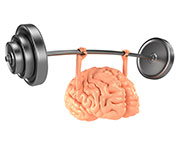This is the final pillar of a six-part series on brain health from Deborah Schrameck, NC, PT, of the Eisenhower Wellness Institute. For previous articles click here.
My final pillar on brain health is “stimulation,” more commonly known as “use it or lose it.” In the Jan/Feb 2011 issue of Desert Health, the article Alzheimer’s and the Brain talks about keeping your brain engaged with games and activities to reduce your risk of Alzheimer’s disease; this article aims to explain why and how.
Let’s first review neuroplasticity and what it means to “use it.” Neuroplasticity is the brain’s ability to change, to even improve, throughout our entire life. The great news in research is that our brain has the ability to constantly reorganize and improve by forming new connections between brain cells or neurons.
When does neuroplasticity occur in the brain?
Infancy: when the immature brain begins to organize itself.
Injury (like stroke): to compensate for lost functions or maximize remaining functions. In the May/June 2014 issue of Desert Health the article Improvement Takes Practice…Especially with Stroke, Stacy Hennis, PT, discussed repetition and the brain’s ability to relearn.
Adulthood: Whenever something new is learned and memorized, more connections are made and strengthened in the brain. This is where we are going to focus, on the enjoyable ways we can boost our own neuroplasticity and brain health.
Did you know that travelling to new places, reading maps and navigating efficiently can increase your brain volume and memory? A study on taxi drivers, the kings of navigation, showed they have larger hippocampi; this is the area that supports consolidation of new information from short-term memory to long-term memory, and that spatially organizes information to enable navigation.
How about picking up a new language to support this world travel? The brains of bilinguals have been shown to be functionally larger than those of us who are monolingual. With brain health, size does matter.
All types of music are enjoyed worldwide. Have you considered learning to play an instrument? Here’s some motivation: brain volume is increased as you learn to play. The musician brain has been shown to have more neuroplasticity and connections. Music increases the areas of the brain responsible for working memory, sound translation and flexibility in thinking. The hand, eye and ear coordination required for playing music increases motor control and coordination. These are all fundamental things that can improve our everyday lives, maybe even our golf game.
Finally, there is a lot of research indicating that learning new abstract information causes beneficial changes in the brain. With abstract information, the brain begins looking for patterns. This causes increased stimulation through analysis. It also supports using your intuition and imagination, further activating and energizing areas of brain function. Almost any new venue of learning from card playing to online games can stimulate and activate your brain.
The goal is to be the perpetual learner, take action, stimulate your brain, use what you’ve been given and encourage your own neuroplasticity. In the Jan/Feb 2017 issue of Desert Health Brian J. Myers, ND, discusses what it takes to change your brain in his article Resolutions: Rewire Your Brain concluding, “It isn’t always easy, but the reward is a new and improved you.”
Deborah Schrameck is a wholistic kinesiologist, health coach, nutritional counselor and personal trainer currently working with the Eisenhower Wellness Institute, AcQpoint Wellness Center and the La Quinta Resort and Club.












































Comments (0)